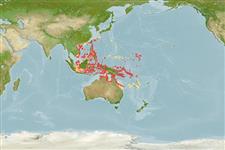Environment: milieu / climate zone / depth range / distribution range
Écologie
marin récifal; profondeur 15 - 30 m (Ref. 48637). Tropical; 30°N - 23°S, 105°E - 171°E
Western Pacific: Ryukyu Islands to Australia. Occurrence of this species in the Indian Ocean is doubtful.
Taille / Poids / Âge
Maturity: Lm ? range ? - ? cm
Max length : 45.0 cm TL mâle / non sexé; (Ref. 9710)
Épines dorsales (Total): 5 - 6; Rayons mous dorsaux (Total): 34-37; Épines anales 3; Rayons mous anaux: 24 - 28. Juveniles are dark brown to black with a brilliant crimson margin around the entire fish (Ref. 1602). Adults dull silver with short fins (Ref. 1602). Body orbicular and strongly compressed, its depth more than twice length of head and 0.9 to 1.3 times in SL. Head length 2.9 to 3.8 times in SL. Large adults (above 35 cm SL) with protruding snout, the front head profile distinctly concave. Interorbital width 34 to 42% head length. Jaws with bands of slender, flattened, tricuspid teeth, the middle cusp about twice length of lateral cusps. Vomer with teeth, but none on palatines. Three or 4 pores on each side of lower jaw. Preopercle smooth. Opercle without spines (Ref 43039).
Adults are generally solitary and found under overhangs of steep outer reef slopes to a depth of at least 20 m. Juveniles are encountered in mangroves and inner sheltered reefs where they seek shelter in caves or under ledges. Feeds on algae as well as jellyfish and other gelatinous zooplankton (Ref. 6113). Sometimes adults are seen in large schools travelling over open substrate (Ref. 48637).
Life cycle and mating behavior
Maturité | Reproduction | Frai | Œufs | Fécondité | Larves
Myers, R.F., 1991. Micronesian reef fishes. Second Ed. Coral Graphics, Barrigada, Guam. 298 p. (Ref. 1602)
Statut dans la liste rouge de l'IUCN (Ref. 130435)
Menace pour l'homme
Harmless
Utilisations par l'homme
Pêcheries: intérêt commercial mineur; Aquarium: Commercial
Plus d'informations
Noms communsSynonymesMétabolismePrédateursÉcotoxicologieReproductionMaturitéFraiRassemblement de ponteFéconditéŒufsDéveloppement de l'œuf
RéférencesAquacultureProfil d'aquacultureSouchesGénétiqueElectrophoresesHéritabilitéPathologiesTraitementNutrientsMass conversion
Outils
Articles particuliers
Télécharger en XML
Sources Internet
Estimates based on models
Preferred temperature (Ref.
123201): 25 - 29, mean 27.9 °C (based on 152 cells).
Phylogenetic diversity index (Ref.
82804): PD
50 = 0.5313 [Uniqueness, from 0.5 = low to 2.0 = high].
Bayesian length-weight: a=0.02692 (0.01137 - 0.06373), b=2.94 (2.74 - 3.14), in cm total length, based on LWR estimates for this (Sub)family-body shape (Ref.
93245).
Niveau trophique (Ref.
69278): 3.7 ±0.29 se; based on food items.
Résilience (Ref.
120179): Milieu, temps minimum de doublement de population : 1,4 à 4,4 années (Preliminary K or Fecundity.).
Fishing Vulnerability (Ref.
59153): Low to moderate vulnerability (35 of 100).
Nutrients (Ref.
124155): Calcium = 44.5 [22.5, 68.1] mg/100g; Iron = 0.587 [0.356, 0.925] mg/100g; Protein = 18.7 [17.5, 19.8] %; Omega3 = 0.0998 [, ] g/100g; Selenium = 30.5 [16.3, 56.4] μg/100g; VitaminA = 81.4 [24.6, 257.6] μg/100g; Zinc = 0.896 [0.611, 1.273] mg/100g (wet weight);
